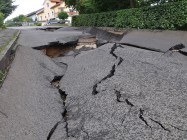Flood waters can be extremely dangerous. FEMA cites, that the force of 6 inches of swiftly moving water can knock people off their feet. Flash flood waters move at very fast speeds and can roll boulders, tear out trees, destroy buildings, and obliterate bridges. Walls of water can reach heights of 10 to 20 feet and generally are accompanied by a deadly cargo of debris.
Flood Preparation & Recovery
It’s important to know the flood risk where you live and work. If you are not sure about potential flooding in your area, you may want to call your local Red Cross chapter for more information. Review the following sections:
- Flood Preparation
- Flood Recovery
- Flood Terminology
Flood Preparation
If your area is at risk from floods, there are flood-specific precautions that can help minimize injuries and damages in the event of a flood. The following are tips for flood preparation:
- If it’s a hard rain that has sustained for several hours or even days, and water is accumulating on the roads and in yards, it is best to guard against flooding.
- You may need to tune in to local radio or TV stations for flood information. It can take several hours or days for these floods to develop.
- It’s important to know the difference between a “flood watch” and a “flood warning.”
- In the event of a flood warning, you should evacuate the effected area as soon as possible and move to higher ground away from any bodies of water and storm drains.
- Learn evacuation routes from home and from work, keeping them in all your vehicles, and include several alternative evacuation routes.
- Abandon your vehicle immediately if, while evacuating the area, your car stalls in rising water and find your way to higher ground. Do not stay in a stalled vehicle.
- Be sure to raise your furnace, water heater and electric panel and circuit breakers if you have time before your evacuation and if they are in areas of your home that may be flooded.
Flood Recovery
Recovery from a flood is just as important as preparation. Be careful not to take safety for granted during the clean-up. Note the following tips for a safe recovery:
- During clean-up, beware of fire hazards, such as electrical appliances that are wet or standing in water and broken gas lines.
- Avoid walking or driving through flood waters.
- If walking through standing water cannot be avoided, wear hearty shoes and use battery-powered lanterns or flashlights when examining buildings.
- Be on the lookout for water snakes and other potentially hazardous animals that may have been displaced or injured during the flood.
- It’s also important to note that flood damage is not covered under many insurance packages. Consider purchasing this additional coverage if you live in an area where flood are likely to occur.
Flood Terminology
The National Flood Insurance Program defines a flood as a general and temporary condition of partial or complete inundation of two or more acres of normally dry land area or of two or more properties (at least one of which is your property) from unusual and rapid accumulation or runoff of surface waters from any source.
dam – and levee- failure floods. These floods occur when the levees and dams, which were built to protect against floods, fail to stop the water.
debris, landslide and mudflow floods – Debris, landslide and mudflow floods are created when the collection of debris, mud, rocks and logs create a dam. When the dam breaks, water and the dam itself wash away, creating a flash flood.
flash flood or flood watch – Flash flooding or flooding is possible within the designated watch area.
flash flood or flood warning – Flash flooding or flooding has been reported or is imminent. Safety steps are necessary immediately.
flash flood or flood statement – This provides follow-up information regarding a flash flood/flood event.
flood interval – The period between floods of a specified magnitude. The 100-year flood refers to the magnitude of a flood that has the probability of occurring once in 100 years.
floodplain – An area adjacent to a body of water.
flood stage – Moment when the water level of a river begins to overflow its banks.
ice-jam floods – These floods occur on rivers that are totally or partially frozen. The ice breaks up during the warmer spring weather and sometimes the pieces create a dam at the narrow section of the river. The water becomes backed up and it causes a flood behind the ice dam. This is usually followed by a flash flood when the dam finally breaks.
regional floods – Floods that occur seasonally when winter or spring rains are joined with melting snow to overfill the river basin too quickly. These floods also occur when the ground is too frozen to absorb the water and it is running off too much into the river basin. Long periods of prolonged rain like thunderstorms, or slow weather systems, also cause regional floods.
storm-surge floods – Storm surges occur when winds push the water unto the land. They usually occur on the edge of the beach, a lake, and rarely on river fronts. It is dangerous because the pounding waves create hazardous flood currents.
“Urban Advisory” or “Small Stream Advisory” – Flooding of small streams, streets and low-lying areas is occurring.
For more tips, go to Tips.acehardware.com.
Published: 3/5/2020

